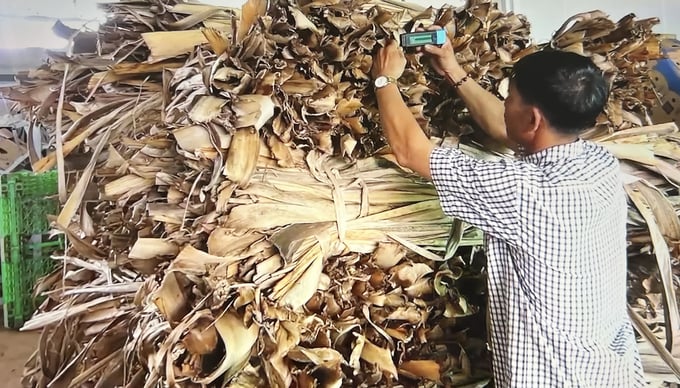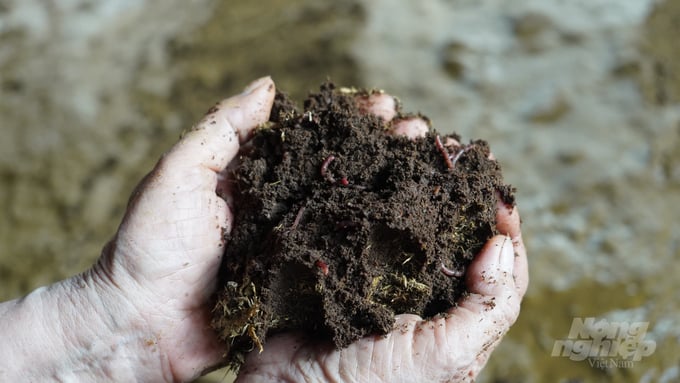May 21, 2025 | 08:02 GMT +7
May 21, 2025 | 08:02 GMT +7
Hotline: 0913.378.918
May 21, 2025 | 08:02 GMT +7
Hotline: 0913.378.918

Banana stalks are split and dried to make fiber and fiber products for export.
Mr. Le Minh Hung, director of Thanh Binh clean agricultural production and consumption link in Dong Nai province shared that the unit has studied and organized the manufacturing of dried banana stalks for export to Europe, Japan, and South Korea by utilizing wasted agricultural byproducts. Consequently, farmers may earn tens of millions of dongs by utilizing the fruit stalk without separating the stalk after harvesting.
Utilizing fresh banana export and processed banana manufacturing to maximum effect, the gathered bananas of the partnership are completely utilized.
The collection, handling, processing, and efficient use of agricultural byproducts have significant implications for environmental preservation, maintaining biodiversity, promoting green, circular agriculture, bringing economic benefits to farmers and the general public, and reducing greenhouse gas emissions.
Thanh Binh Cooperative is the pioneer in implementing a circular economic model in agriculture based on the deep processing of banana goods. Specifically, banana fiber and banana fiber products made from dried banana stalks are used as raw materials in producing a variety of eco-friendly handicrafts and home goods supplied to Europe, Japan, and South Korea. This not only makes use of the discarded banana stems following harvest but also provides farmers with prospects for sustainable banana development.
Mr. Ly Minh Hung stated that in the near future, the cooperative would continue to expand its product line, strive for a closed processing system, and waste practically no portion of the banana tree in order to boost the value of this commodity in the "banana hub."
T&T 159 Hoa Binh Seed & Feed Joint Stock Company (Hoa Binh province) has balanced waste streams from many stages to provide input materials for each closed stage of agriculture - breeding - environmental treatment - producing beneficial goods for the cycling society.
At the end of the cycle, the business produces two products: fattening beef (for meat) and microbiological organic fertilizer.
With a breeding scale of 20,000 to 28,000 (turns) of buffaloes and cows per farm, each farm and production complex annually collects and processes 200,000 tons of agricultural by-products to produce livestock feed, 150,000 tons of other by-products as biological buffers, and 60,000 tons of organic fertilizers as input materials.
In 2016, the firm gathered and processed 43,500 tones of by-products worth VND 44 billion; in 2017, it will collect and process 32,000 tons of by-products worth VND 30 billion; and by 2020, it will have collected and processed 123,000 tons of by-products worth VND 137 billion.

Taking advantage of cow manure to raise earthworms to fertilize crops is being applied by many households, cooperatives and businesses, bringing high economic efficiency.
According to a representative of the Vietnam Association of Farms and Agricultural Enterprises, livestock households still account for 55% in terms of quantity and 45% in terms of output, with discarding by-products (feces, urine) accounting for 61 million tons of feces and approximately 290 million tons of waste. In order to effectively incorporate livestock, agriculture, and manure processing into a circular economic cycle, it is required to overcome the problem of effective harmonization between these three sectors.
The current requirement for fodder (byproduct) for livestock is 75 million tons, while the livestock development strategy will require around 128 million tons by 2030.
In a situation of extremely high food costs, it is vital to have timely policies for sustainable development and timely linkages to convert waste into useful resources, in order to minimize the environment and to have input goods. "high," a Vietnam Association of Farms and Agricultural Enterprises spokesman stated.
According to Ms. Ha Thuy Hanh, Deputy Director of the National Agricultural Extension Center, the traditional VAC (derived from the three Vietnamese terms Vuon, garden or orchard, Ao, fish pond, and Chuong, pigsty or poultry barn) has accomplished a great deal in the past. Current agricultural extension programs include several shrimp-fish, shrimp-rice, shrimp-fish-rice, and rice-shrimp-duck models based on the principles of circular agriculture.
The National Agricultural Extension Center is executing two significant models of crop and livestock-based circular agriculture, including fattening beef cattle and cultivating maize for biomass. Ms. Hanh stated, however, that there are several practical models that farmers use, but they must be replicated into models that can be broadly used based on each ecological location and each season, particularly when climate change impacts farming.
"The National Agricultural Extension Center has a wide variety of models pertaining to agriculture, animal husbandry, and aquaculture, however, the cyclical model only accounts for 12 to 14 percent. In accordance with the Ministry of Agriculture and Rural Development's directives, we pay greater attention to the value chain and increase the value of brand products, as stated by Ms. Hanh.
According to Ms. Hanh, in the future, in addition to agricultural mechanization, microbiological technology will play a significant role in the utilization of renewable energy and reuse, so that in a circular process nothing is wasted and the result of one process becomes the input of the next.
In order to replace chemical fertilizers with organic fertilizers, it is required to improve the dissemination of knowledge and the promotion of efficient models. There are training programs and communication training pertaining to circular agriculture, regenerative agriculture, and organic usage.
It is recommended to construct extension models connected to in-situ recycling, since this is a crucial component, as the proportion of homes is still relatively high, and in-situ circular agriculture is crucial for reusing byproducts in both households and general programs.
Future Vietnamese agriculture must rely more on information since the development of circular agriculture has become a trend in many nations.
According to research conducted by experts, the successful application of the circular economy to renewable post-harvest waste sources would cut production costs, boost competitiveness, and generate USD 4.5 trillion in global development opportunities by 2030.
Translated by Linh Linh

(VAN) Japan's grant aid project contributes to capacity building, promoting organic agricultural production, and fostering sustainable community development in Dong Thap province.

(VAN) For years, the CRISPR-Cas9 genome technology has been reshaping genetic engineering, a precision tool to transform everything from agriculture to medicine.

(VAN) Vietnam aims to become a 'leader' in the region in the capacity and managing effectively soil health and crop nutrition.
![Reducing emissions from rice fields: [Part 1] Farming clean rice together](https://t.ex-cdn.com/nongnghiepmoitruong.vn/608w/files/news/2025/05/05/z6509661417740_a647202949c539012a959e841c03e1d3-nongnghiep-143611.jpg)
(VAN) Growing clean rice helps reduce environmental pollution while increasing income, allowing farmers to feel secure in production and remain committed to their fields for the long term.
/2025/05/19/5136-1-144800_230.jpg)
(VAN) The Nghe An Provincial People's Committee has just approved the list of beneficiaries eligible for revenue from the Emission Reductions Payment Agreement (ERPA) in the North Central region for the year 2025.

(VAN) 14 out of 35 domesticated elephants in Dak Lak province have had their living conditions improved, with 11 of them currently participating in the non-riding elephant tourism model.

(VAN) Muong Nhe Nature Reserve hopes that being upgraded to a national park will lay the foundation for forest protection efforts to be carried out in a systematic, modern, and sustainable manner.